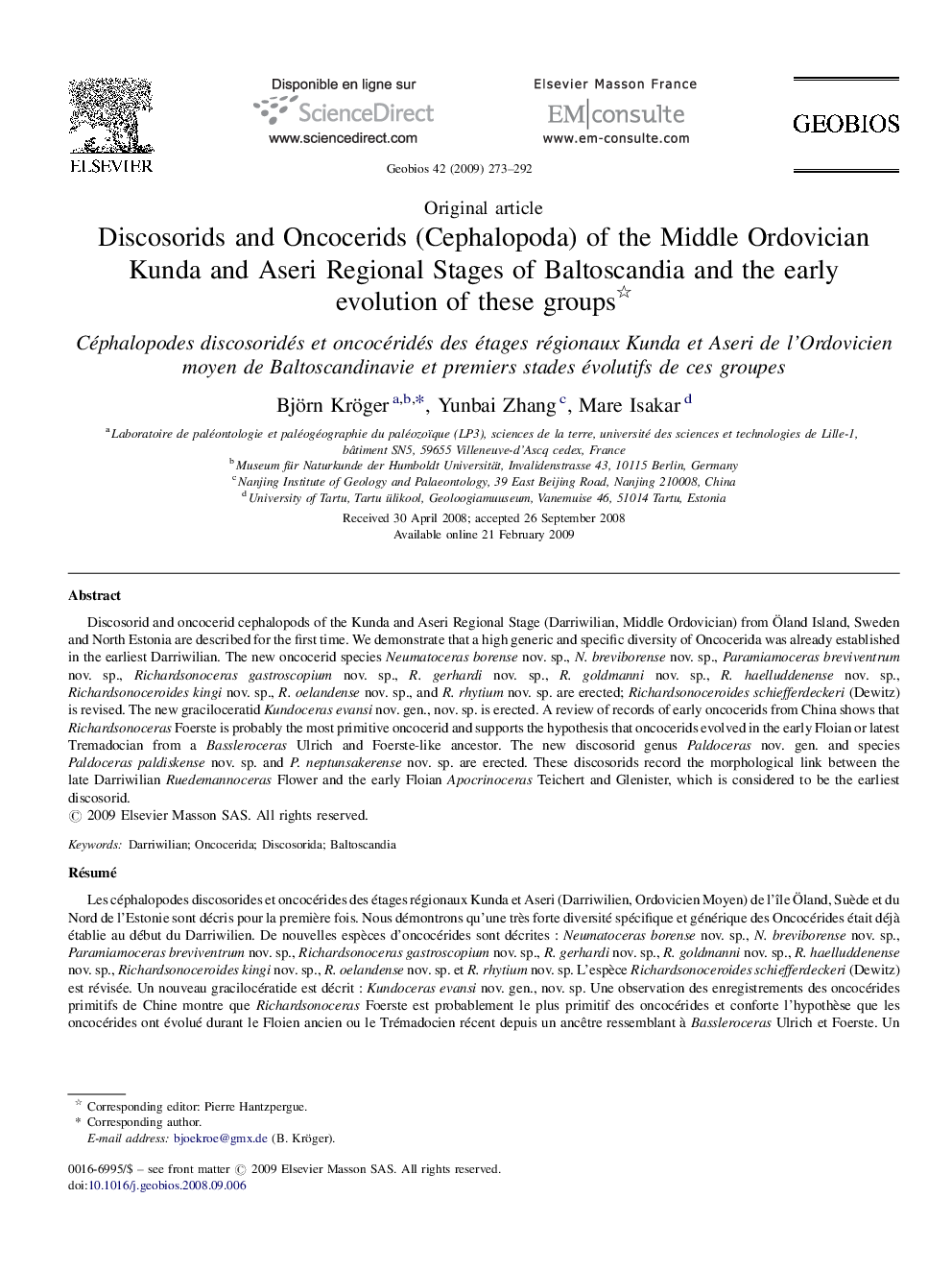| کد مقاله | کد نشریه | سال انتشار | مقاله انگلیسی | نسخه تمام متن |
|---|---|---|---|---|
| 4748556 | 1360118 | 2009 | 20 صفحه PDF | دانلود رایگان |

Discosorid and oncocerid cephalopods of the Kunda and Aseri Regional Stage (Darriwilian, Middle Ordovician) from Öland Island, Sweden and North Estonia are described for the first time. We demonstrate that a high generic and specific diversity of Oncocerida was already established in the earliest Darriwilian. The new oncocerid species Neumatoceras borense nov. sp., N. breviborense nov. sp., Paramiamoceras breviventrum nov. sp., Richardsonoceras gastroscopium nov. sp., R. gerhardi nov. sp., R. goldmanni nov. sp., R. haelluddenense nov. sp., Richardsonoceroides kingi nov. sp., R. oelandense nov. sp., and R. rhytium nov. sp. are erected; Richardsonoceroides schiefferdeckeri (Dewitz) is revised. The new graciloceratid Kundoceras evansi nov. gen., nov. sp. is erected. A review of records of early oncocerids from China shows that Richardsonoceras Foerste is probably the most primitive oncocerid and supports the hypothesis that oncocerids evolved in the early Floian or latest Tremadocian from a Bassleroceras Ulrich and Foerste-like ancestor. The new discosorid genus Paldoceras nov. gen. and species Paldoceras paldiskense nov. sp. and P. neptunsakerense nov. sp. are erected. These discosorids record the morphological link between the late Darriwilian Ruedemannoceras Flower and the early Floian Apocrinoceras Teichert and Glenister, which is considered to be the earliest discosorid.
RésuméLes céphalopodes discosorides et oncocérides des étages régionaux Kunda et Aseri (Darriwilien, Ordovicien Moyen) de l’île Öland, Suède et du Nord de l’Estonie sont décris pour la première fois. Nous démontrons qu’une très forte diversité spécifique et générique des Oncocérides était déjà établie au début du Darriwilien. De nouvelles espèces d’oncocérides sont décrites : Neumatoceras borense nov. sp., N. breviborense nov. sp., Paramiamoceras breviventrum nov. sp., Richardsonoceras gastroscopium nov. sp., R. gerhardi nov. sp., R. goldmanni nov. sp., R. haelluddenense nov. sp., Richardsonoceroides kingi nov. sp., R. oelandense nov. sp. et R. rhytium nov. sp. L’espèce Richardsonoceroides schiefferdeckeri (Dewitz) est révisée. Un nouveau gracilocératide est décrit : Kundoceras evansi nov. gen., nov. sp. Une observation des enregistrements des oncocérides primitifs de Chine montre que Richardsonoceras Foerste est probablement le plus primitif des oncocérides et conforte l’hypothèse que les oncocérides ont évolué durant le Floien ancien ou le Trémadocien récent depuis un ancêtre ressemblant à Bassleroceras Ulrich et Foerste. Un nouveau genre et deux nouvelles espèces de discosorides ont été créés : Paldoceras nov. gen., Paldoceras paldiskense nov. sp. et P. neptunsakerense nov. sp. Ces discosorides enregistrent le lien morphologique entre Ruedemannoceras Flower du Darriwilien récent et Apocrinoceras Teichert et Glenister du Floien ancien qui est considéré comme le discosoride le plus ancien.
Journal: Geobios - Volume 42, Issue 3, May–June 2009, Pages 273–292